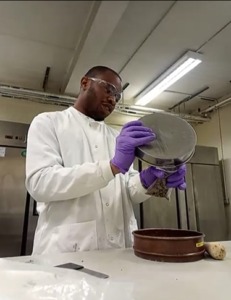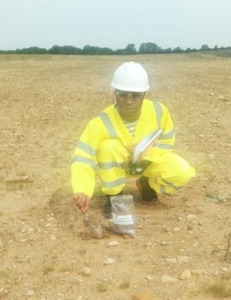Exploring the world beneath our feet!
11/10/2023

Hi readers! I’m Marvellous Christopher Etuk, an environmental engineer passionate about restoring degraded ecosystems through soil science. I recently completed my MSc in Environmental Engineering at Cranfield University in the UK. Through my MSc thesis, I got linked with Hanson, UK who are my sponsors for the project on microbial community structure in restored quarried grasslands. In addition to the data skills in principal component analysis, I have garnered fine skills from field-to-lab experience in visual soil assessment, phospholipid fatty acid analysis (PLFA), microbial biomass, and available nitrogen and phosphorus through this project. These experiences showed me how applied science can develop sustainable solutions tailored to local contexts. As an emerging steward of our shared planet, I’m eager to join mission-driven organizations advancing biodiversity conservation, regeneration, and land restoration. I also hope to continue pursuing research uncovering novel nature-based strategies to add to the pool of scientific bodies and benefit communities.
On this blog, I look forward to sharing my perspectives as an early career scientist. From exploring soil microbiomes to highlighting promising technologies, I aim to make science accessible while driving impact. I believe ecology should empower, not overwhelm us. Let’s grow our wonder for the living world! I’m glad you’re joining me on this journey to dig into our marvellous planet. Let’s get started!
When we think of biodiversity, oftentimes the focus is on larger lifeforms we can see above ground; big animals like elephants or trees probably come to mind. But did you know there’s a whole hidden world of diversity living right beneath our feet?
Inside every spoonful of soil are billions of tiny living things – algae, fungi, bacteria, protozoa. Together, these microscopic soil organisms are called microbiomes. Though invisible to our eyes, soil microbiomes powerfully impact ecosystems and our lives. Much like how COVID brought societies to a halt, soil organisms exert tremendous invisible influence.
Growing up, I learned it’s often the smallest things that have the biggest effects. The fertile soils that grow our food rely on the diversity of microbial communities living symbiotically with plant roots. These microbiomes recycle nutrients, store carbon, unlock essential minerals for vegetation (above-ground biodiversity), and even regulate the entire planet’s climate! Yet modern practices from tillage to pesticides can disrupt these essential partnerships, throwing off natural balances.
Soil microbiomes let ecosystems flourish the way our gut microbiome keeps us healthy. And we’re just beginning to unlock their incredible secrets! Hanson and Ketton Quarry are using innovative tools to study how land management choices impact these communities. Just like how a doctor analyses your microbiome to offer health advice, soil samples help experts recommend steps to restore the habitats of these soil microbiomes. Hanson and Ketton Quarry actively work to conserve and rebuild microbial biodiversity through sustainable land management strategies tailored to local ecology. Recent research by myself and colleagues evaluating quarry restoration sites, particularly at Ketton Quarry found management options ranging from reduced soil disturbance, and seed mixes to organic amendments can help improve belowground diversity.
Here are three simple ways YOU can help conserve these soil microscopic helpers:
- Grow native plants – their roots nourish unique underground species.
- Reduce chemical fertilizers and pesticides – they harm essential fungi and bacteria.
- Limit soil disturbance – tillage and compaction disrupt delicate communities.
By getting smart about belowground biodiversity, we can nourish healthier soils to grow more resilient crops, support carbon storage, and maintain the interconnected web of life. When it comes to conservation, small things count in a very big way! What are you doing to take care of the little things? So, let’s spread the word to get others excited about the tiny ecosystems under their feet with conservation at the forefront!!


Categories & Tags:
Leave a comment on this post:
You might also like…
Creating and using constituent lists in Datastream
Whether you're analysing industry performance, or comparing company financials, Datastream is a powerful tool. One of its most useful features is the ability to work with constituent lists — collections of companies grouped by index, ...
Landing at Cranfield: First-term experiences and life beyond the classroom
Starting a postgraduate course can feel daunting, especially if you’re new to the aviation industry. In this blog series, Adit Shah shares his journey on the Air Transport Management MSc at Cranfield. From first-term ...
Accelerating ambition: How Amelie Rohan engineered her future at Cranfield
In the world of high-performance automotive engineering, the gap between being a “fan” and being a professional is measured in more than just miles. It is measured in technical precision, hands-on ...
Study better and smarter in 2026
Happy new year! Now is the perfect time to reflect on your studies so far, thinking about what you’re doing well and where you need to focus a bit more attention. Getting back into ‘study ...
Cleared for the future: Why aviation leaders must embrace environmental sustainability
Environmental sustainability is not a niche concern for aviation anymore, it’s central to how we think about the future of our industry. In my work as an Associate Professor of Airport Decarbonisation, I see first-hand ...
Preparing your work for Turnitin submission
Before submitting your work into Turnitin for similarity checking, if you have used referencing software then you may need to take some important steps first. Mendeley and Zotero integrate with MS Word by embedding field ...






